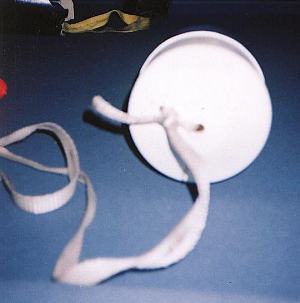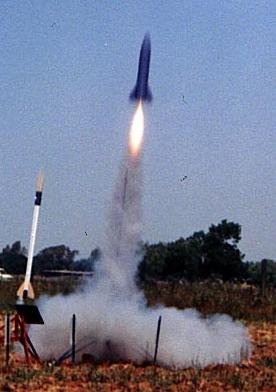LOC/Precision Minie-Magg
LOC/Precision - Minie-Magg {Kit} (PK-5) [1985-]
Contributed by Bryan M. Chuck
| Construction Rating: | starstarstarstarstar_border |
| Flight Rating: | starstarstarstarstar |
| Overall Rating: | starstarstarstarstar_border |
| Manufacturer: | LOC/Precision  |
 Brief:
Brief:
LOC's Minie-Magg is a single-staged HP rocket popular with many fliers. Its stubby profile combined with a basic build make it a fun flier for larger motors, as well as smaller H motors for a lesser field.
Construction:
The parts were contained in a durable plastic bag. The inventory of parts are as follows:
- 1 nosecone, plastic
- 1 kraft paper airframe 5.54" diameter (fin slots pre-cut)
- 1 kraft paper 38mm motor tube
- 2 birch ply centering rings
- 3 birch ply fins
- 1 elastic shock cord
- 1 braided nylon shock cord mount
- 1 nylon parachute (mine is bright orange)
- 1 launch lug (1/2" diameter)
I felt the components to be a fine quality, and found no warping of the fins.
Outside of the Minie Magg's size, it is a basic build. I used 15 minute epoxy for the assembly and 30 minute on fillets. The instructions are simple to follow and are included on the back-side of the info/picture card. I would speculate that a person should have no problems assembling this rocket from the instructions LOC supplies.
 All the parts fit together well and required minimal, if any sanding. I decided to deviate slightly from the instructions, though, in order to add a few things to improve the longevity of my Minie-Magg. The supplied shock cord mount is epoxied on the inside side of the airframe, and uses elastic for shock cord material. I did not feel confident using this arrangement, so I put an eyebolt in the forward centering ring to anchor the shock cord. I also opted to use 20' of tubular nylon in lieu of the elastic. Attaching the cord to the eyebolt was done via quick link. I also felt the plastic eyelet on the nosecone would prove weak on this larger rocket. To remedy this, I drilled a 1/2 hole in the base of the nosecone, passed my shockcord through it, and passed it back through the hole pre-existing at the bottom center of the nosecone. Thus far, it has held up well.
All the parts fit together well and required minimal, if any sanding. I decided to deviate slightly from the instructions, though, in order to add a few things to improve the longevity of my Minie-Magg. The supplied shock cord mount is epoxied on the inside side of the airframe, and uses elastic for shock cord material. I did not feel confident using this arrangement, so I put an eyebolt in the forward centering ring to anchor the shock cord. I also opted to use 20' of tubular nylon in lieu of the elastic. Attaching the cord to the eyebolt was done via quick link. I also felt the plastic eyelet on the nosecone would prove weak on this larger rocket. To remedy this, I drilled a 1/2 hole in the base of the nosecone, passed my shockcord through it, and passed it back through the hole pre-existing at the bottom center of the nosecone. Thus far, it has held up well.
Another minor "CON" to this rocket is the fins do not go all the way to the motor tube. To make amends, I decided to keep the aft centering ring off until after I put the fins on. On the inside of the airframe where the fin tabs came barely through, I put 2 inch wide fiberglass bandaids the length of the fin root.
Lastly, I added t-nut & brass strip Kaplow-style motor retention before adding the aft centering ring.
As for building, here are my thoughts: PROS 1. Quality of airframe, wood components, and nosecone. 2. Exceptional fitting of parts. 3. Simplicity of build/instructions, even if built "stock."
CONS 1. Shock cord attachment and shock cord material. 2. Fins are not to the motor tube. 3. Lack of motor retention, which is fairly common in mid-power and HP rockets.
Finishing:
To finish off my Minie-Magg, I filled the tube spirals with 3M Spot Putty. On the fins, I used a couple coats of SIG sanding sealer from the local R/C plane store. After sanding things smooth, I employed two light coats of white Krylon primer, sanding between coats. For my color coat, I chose Glossy Krylon Grape. I chose this color in honor of my friends' daughter, whose name is Violet and likes rockets.
Construction Rating: 4 out of 5
 Flight:
Flight:
Flight prep for this rocket is easy. It's wide enough to fit all recovery items with no hassle. Instead of the large amount of wadding the Minie Magg would require, a 18"x18" piece of Top Flight Nomex was used. I also added one of their Nomex sleeves for good measure. The LOC catalog notes that one could fly this rocket with a G80 SU motor.
The maiden flight of my Minie-Magg was at Black Rock XII in Nevada. I chose an I161 medium for the ice breaker. It was a good choice and recovery happened without a hitch. At this point, I've gone as large as an I211. All flights have been arrow straight, and exceptional "rock & roll" motors for this rocket seem to be the I300, I357, and of course, the I211. For good measure, my breakdown of motors used in the Minie-Magg are thus:
- H123
- H242
- I161
- I300
- I357
- I211
I've had only one incident when the fin popped loose. In light of that, I would rate the Minie-Magg's flying and prep at a top notch 5.
Recovery:
No cons regarding flight recovery after swapping out the shock cord and using a different anchoring system. Pros: Stock 'chute seems adequate.
Flight Rating: 5 out of 5
Summary:
I'm quite pleased with this rocket. In my opinion, it only needs a couple of things added to improve it: Shock cord and shock cord attachment. Also fin root strengthening is probably a good idea. Even if built stock, the parts are outstanding in their fit and quality, and the build is straightforward. Overall, it's a fun flier. I'm constantly amazed at how many Minie-Magg's I see at launches. I believe it's a fine L1 rocket on the H123, also.
Overall Rating: 4 out of 5
Other Reviews
- Loc Precision Minie-Magg By Theresa Pantoja (August 19, 2020)
This kit is great for people who want a fun high powered rocket. The size is not cumbersome and the build is not complicated. Components Model: 07653 Skill Level 3: Average Skills Needed Length: 37.000" (93.98 cm) Weight: 53.000 oz (1502.52 g) Diameter (Max): 5.540" (14.07 cm) Fin Count: 3 Motor Size: ...
- LOC/Precision Minnie-Mag By David Hunt (January 18, 2017)
This was my first High Power Rocket. I certified L1 and L2 with this same rocket. It is very easy to build. LOC"s "LOC-N-Fin" method of using fin tabs inside to air frame worked very well. With the tabs installed the fins naturally fell into the proper perpendicular orientation. With the big 5.5" air frame applying epoxy to all the interior parts was very ...
 |
 |
Flights
 |
 |
J.T. (September 19, 2001)
J.J. (January 1, 2002)
S.M. (February 15, 2002)
M.L. (February 7, 2007)
Sponsored Ads
 |
 |












D.G. (August 1, 2001)